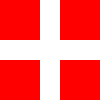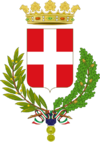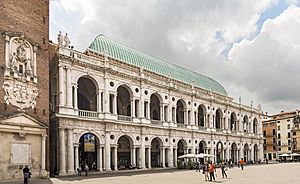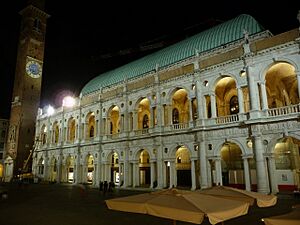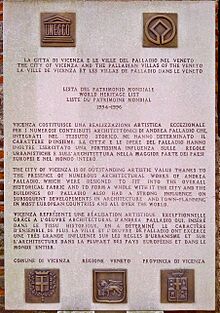Vicenza facts for kids
Quick facts for kids
Vicenza
Vicensa (Venetian)
|
|||
|---|---|---|---|
| Città di Vicenza | |||
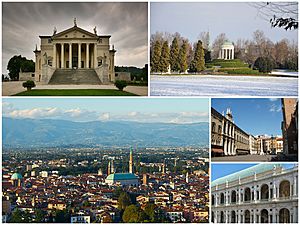
Clockwise from top: Villa La Rotonda; the classical temple in the Parco Querini; Piazza dei Signori; the Renaissance Basilica Palladiana; and a panorama of the city from the Monte Berico
|
|||
|
|||
| Country | Italy | ||
| Region | Veneto | ||
| Province | Province of Vicenza (VI) | ||
| Area | |||
| • Total | 80 km2 (30 sq mi) | ||
| Elevation | 39 m (128 ft) | ||
| Population
(30 June 2017)
|
|||
| • Total | 111,980 | ||
| • Density | 1,400/km2 (3,630/sq mi) | ||
| Demonym(s) | Vicentini | ||
| Time zone | UTC+1 (CET) | ||
| • Summer (DST) | UTC+2 (CEST) | ||
| Postal code |
36100
|
||
| Dialing code | 0444 | ||
| Patron saint | Madonna of Monte Berico | ||
| Saint day | September 8 | ||
| UNESCO World Heritage Site | |
|---|---|

Piazza dei Signori
|
|
| Part of | City of Vicenza and the Palladian Villas of the Veneto |
| Criteria | Cultural: i, ii |
| Inscription | 1994 (18th Session) |
| Area | 218 ha (540 acres) |
Vicenza is a city in northeastern Italy. It is located in the Veneto region, at the base of Monte Berico. The River Bacchiglione flows through the city. Vicenza is about 60 kilometers (37 miles) west of Venice. It is also about 200 kilometers (124 miles) east of Milan.
Vicenza is a busy and diverse city. It has a rich history and culture. You can find many museums, art galleries, and beautiful buildings here. These include piazzas (public squares), villas, churches, and elegant Renaissance palazzi (palaces). The city is famous for its architecture by Andrea Palladio. Because of his amazing work, Vicenza was named a UNESCO World Heritage Site in 1994. This includes the "city of Palladio" and the Palladian villas of the Veneto nearby.
In 2008, Vicenza had about 115,927 people. Its larger metropolitan area had around 270,000 people. Vicenza is a major industrial center in Italy. It is known for its textile and steel industries. These industries provide many jobs. A large part of Italy's gold and jewelry is also made here. This greatly helps the city's economy. The computer parts industry is also important. For example, Federico Faggin, who helped invent the microprocessor, was born in Vicenza.
Contents
History of Vicenza
Early Times
The area of Vicenza was first settled by the Euganei tribe. Then, the Paleo-Veneti tribe lived there in the 3rd and 2nd centuries BC. The Romans became friends with the Paleo-Veneti. They fought together against other tribes in northern Italy. Over time, the Romans became more present in the area. The Paleo-Veneti slowly became part of the Roman culture.
In 157 BC, the city became a Roman center. It was called Vicetia or Vincentia. This name means "victorious." In 49 BC, the people of Vicetia became Roman citizens. The city was known for its farming, brick making, and wool. It was also a stop on an important road from Milan to Aquileia. However, it was not as big as its neighbor, Padua. Not much of the Roman city remains today. But three bridges over the Bacchiglione and Retrone rivers are from Roman times. Some parts of a Roman aqueduct can also be seen.
Middle Ages
After the Western Roman Empire declined, different groups attacked the area. These included the Heruls, Vandals, Visigoths, and Huns. But the city recovered after the Ostrogoths took over in 489 AD. Later, it was ruled by the Byzantine Empire. Vicenza was also an important city for the Lombards and then the Franks. Many Benedictine monasteries were built in the area starting in the 6th century.
In 899, Magyar raiders destroyed Vicenza. In 1001, Otto III gave control of the city to the bishop. This helped the city's own government grow. Vicenza joined the Lombard League (1164–1167) against Emperor Frederick I Barbarossa. After peace, rivalries with other cities like Padua began again. There were also fights between local groups.
A powerful leader named Ezzelino III da Romano ruled Vicenza. After he died, the city's old government returned. It had a "grand council" and a "small council." In 1311, Vicenza came under the rule of the Scaligeri lords of Verona. They made the city stronger against the Visconti of Milan.
In 1404, Vicenza became part of the Republic of Venice. Its history then followed that of Venice. The city was attacked by Emperor Sigismund. Maximilian I also held it in 1509 and 1516.
Later History
The 16th century was important for Andrea Palladio. He was a famous architect who designed many buildings in Vicenza. His work made the city much more beautiful.
After the Fall of the Venetian Republic in 1797, Napoleon took control. Vicenza became a special duchy in Napoleon's Kingdom of Italy. A valuable silver model of the city, called the Jewel of Vicenza, was destroyed during this time.
After 1814, Vicenza became part of the Austrian Empire. But in 1848, the people of Vicenza fought against Austria. They showed great courage. The city was later joined with Italy after the Third War of Italian independence.
Vicenza was a major battle area in both World War I and World War II. It was the most damaged city in Veneto by Allied bombings in World War II. Over 2,000 civilians died. After the wars, the city faced tough times. But in the 1960s, the area saw strong economic growth. Many small family businesses started up. This led to what was called the "miracle of the northeast." In recent years, the economy has grown a lot. New industrial areas have appeared around the city.
Today, Vicenza is home to the US Army base Caserma Ederle (Camp Ederle). This base became the headquarters of the Southern European Task Force in 1965. The European Gendarmerie Force also started in Vicenza in 2006.
Geography and Climate
Vicenza is in the Veneto region of Italy. It sits at the northern base of Monte Berico. The Bacchiglione River flows through the city. Vicenza is about 60 kilometers (37 miles) west of Venice. It is also about 200 kilometers (124 miles) east of Milan.
Climate in Vicenza
Vicenza has a humid subtropical climate. Summers are hot and humid. Winters are cold and damp. The average temperature in January is about 3°C (37°F). In July, the average temperature is about 23.4°C (74°F). The city gets a fair amount of rain throughout the year.
| Climate data for Vicenza (1971–2000, extremes 1951–2008) | |||||||||||||
|---|---|---|---|---|---|---|---|---|---|---|---|---|---|
| Month | Jan | Feb | Mar | Apr | May | Jun | Jul | Aug | Sep | Oct | Nov | Dec | Year |
| Record high °C (°F) | 15.9 (60.6) |
21.7 (71.1) |
26.8 (80.2) |
30.0 (86.0) |
34.8 (94.6) |
37.4 (99.3) |
37.4 (99.3) |
38.2 (100.8) |
33.2 (91.8) |
29.4 (84.9) |
24.4 (75.9) |
17.8 (64.0) |
38.2 (100.8) |
| Mean daily maximum °C (°F) | 7.0 (44.6) |
9.3 (48.7) |
13.5 (56.3) |
17.3 (63.1) |
22.8 (73.0) |
26.2 (79.2) |
29.1 (84.4) |
28.7 (83.7) |
24.3 (75.7) |
18.4 (65.1) |
11.8 (53.2) |
7.5 (45.5) |
18.0 (64.4) |
| Daily mean °C (°F) | 3.0 (37.4) |
4.6 (40.3) |
8.4 (47.1) |
12.1 (53.8) |
17.4 (63.3) |
20.8 (69.4) |
23.4 (74.1) |
22.9 (73.2) |
18.9 (66.0) |
13.5 (56.3) |
7.5 (45.5) |
3.5 (38.3) |
13.0 (55.4) |
| Mean daily minimum °C (°F) | −1 (30) |
−0.1 (31.8) |
3.3 (37.9) |
7.0 (44.6) |
11.9 (53.4) |
15.5 (59.9) |
17.7 (63.9) |
17.2 (63.0) |
13.5 (56.3) |
8.5 (47.3) |
3.1 (37.6) |
−0.4 (31.3) |
8.0 (46.4) |
| Record low °C (°F) | −20 (−4) |
−18.6 (−1.5) |
−10 (14) |
−3.2 (26.2) |
−0.8 (30.6) |
2.6 (36.7) |
9.5 (49.1) |
8.0 (46.4) |
3.8 (38.8) |
−3.6 (25.5) |
−8 (18) |
−13 (9) |
−20.0 (−4.0) |
| Average precipitation mm (inches) | 76.5 (3.01) |
67.9 (2.67) |
76.9 (3.03) |
97.3 (3.83) |
100.0 (3.94) |
104.3 (4.11) |
74.0 (2.91) |
79.5 (3.13) |
92.7 (3.65) |
115.5 (4.55) |
93.7 (3.69) |
81.5 (3.21) |
1,059.8 (41.73) |
| Average precipitation days (≥ 1.0 mm) | 7.0 | 5.0 | 6.4 | 9.5 | 10.0 | 9.3 | 6.8 | 6.7 | 6.1 | 7.5 | 7.1 | 6.4 | 87.8 |
| Average relative humidity (%) | 81 | 77 | 73 | 74 | 72 | 73 | 72 | 73 | 74 | 78 | 80 | 82 | 76 |
| Source: Servizio Meteorologico (humidity 1961–1990) | |||||||||||||
People of Vicenza
| Historical population | ||
|---|---|---|
| Year | Pop. | ±% |
| 1871 | 37,475 | — |
| 1881 | 38,713 | +3.3% |
| 1901 | 43,703 | +12.9% |
| 1911 | 53,107 | +21.5% |
| 1921 | 59,611 | +12.2% |
| 1931 | 64,372 | +8.0% |
| 1936 | 69,379 | +7.8% |
| 1951 | 79,862 | +15.1% |
| 1961 | 98,019 | +22.7% |
| 1971 | 116,620 | +19.0% |
| 1981 | 114,598 | −1.7% |
| 1991 | 107,454 | −6.2% |
| 2001 | 107,223 | −0.2% |
| 2011 | 111,500 | +4.0% |
| 2021 | 110,293 | −1.1% |
| Source: ISTAT | ||
In 2007, Vicenza had about 114,268 residents. About 17% were children and teens (under 18). About 21% were retired people. The average age of people in Vicenza is 43. Between 2002 and 2007, the city's population grew by about 3.7%.
In 2010, most people (83.5%) in Vicenza were Italian. From 1876 to 1976, over 1 million people from the Vicenza area moved away. Many went to countries like Brazil, the United States, Canada, and Australia. They left due to difficult times. Today, almost 100,000 Vicenza citizens live and work abroad. Now, Vicenza also welcomes people from other countries.
The largest group of immigrants comes from the United States. This is partly because of the military base there. Other groups come from European nations like Serbia and Romania. There are also people from South Asian countries like Bangladesh and Pakistan. Most people in Vicenza are Roman Catholic. But due to immigration, there are also Orthodox Christian, Muslim, and Sikh communities.
Architecture and Famous Buildings
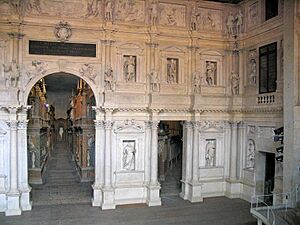

In 1994, UNESCO added "Vicenza, City of Palladio" to its list of World Heritage Sites. In 1996, the site grew to include the Palladian villas outside the city. It was then renamed "City of Vicenza and the Palladian Villas of the Veneto".
Palladio's Amazing Works
Vicenza has twenty-three buildings designed by the famous architect Palladio. Some well-known examples include:
- Basilica Palladiana: This building is in the main square, Piazza dei Signori. Palladio himself said it was as good as any ancient building.
- Teatro Olimpico: This "Olympic Theater" was designed for the Accademia Olimpica. Palladio started building it in 1580, but he died that year. The wooden stage scenes were made by Vincenzo Scamozzi.
- Villa Almerico Capra (also called "La Rotonda"): This beautiful villa is just outside the city center.
- Palazzo Chiericati: This palace now holds the city's art collection.
- Palazzo Barbaran da Porto: This building is home to the Museo Palladio.
- Palazzo del Capitaniato: This is where the city council meets.
- Palazzo Porto
- Palazzo Porto in Piazza Castello (not fully finished)
- Palazzo Thiene Bonin Longare (built by Vincenzo Scamozzi)
- Palazzo Thiene
- Villa Gazzotti Grimani: This villa is in the Bertesina area.
Other Interesting Sights
Churches to Visit
Here are some of the main historical churches in Vicenza:
- Cathedral of Vicenza: This church dates back to the early 11th century. It has been rebuilt many times, especially after damage in World War II. It holds many paintings and sculptures by local artists. Palladio designed the dome and a side door.
- Basilica Sanctuary of Saint Mary of Monte Berico: This large church was built in two parts. The first part was Gothic style (1428). The second part was Baroque style (1703). It has a large painting by Paolo Veronese. The church remembers two times the Virgin Mary appeared to a woman named Vincenza Pasini. It also celebrates the city being saved from a terrible plague.
- Basilica of Santi Felice and Fortunato: This church was built in the 4th century over a Roman cemetery. It was made larger in the 5th century. It was destroyed by the Hungarians in the 9th century but rebuilt. It looks like an early Christian church. There is a small museum next to it with old items found there.
- Santa Corona: This is one of the oldest and most important churches. It was built in the 13th century to hold one of the thorns from Christ's crown. It has paintings by famous artists like Giovanni Bellini. The crypt has the Valmarana chapel designed by Palladio.
- San Lorenzo (1280): This church was built by minorites (a type of friar). It has a mix of Gothic and Romanesque styles. It holds the tombs of important people from Vicenza.
- Santa Maria Nova: This late 16th-century church is the only religious building fully designed by Palladio in Vicenza.
- San Marco in San Girolamo (early 18th century): This church was built in the late Baroque style. It has many artworks by local and Venetian artists.
Other Buildings to See
- The Torre Bissara (clock tower) (1174): This tower is 82 meters (269 feet) tall. It is one of the tallest buildings in the city.
- The Biblioteca Civica Bertoliana: This is a public library. It was started by Count Giovanni M. Bertolo in 1708.
- Casa Pigafetta (1440): This was the home of Antonio Pigafetta, a famous explorer.
- The Pinacotheca Civica: This art gallery is located in the Palladian Palazzo Chiericati. It mainly shows paintings by artists from Vicenza.
Economy and Transportation
The area around Vicenza is mostly farmland. Important products include wine, wheat, corn, and olive oil. Cherries and asparagus from the area are also well-known. There are also quarries for marble and mines for sulfur, copper, and silver. Mineral springs are common, with the most famous being in Recoaro.
Large industrial areas are found around the city. Many steel and textile factories are in the western and eastern parts of the region.
Important industries in Vicenza are jewelry and clothing. Famous clothing companies like Diesel and Bottega Veneta are from here. The Gold Exposition, a world-famous event, happens in Vicenza twice a year. Other industries include wool, silk, pottery, and musical instruments. The companies Campagnolo (bicycle parts) and Dainese (sports protective gear) also have their main offices here.
Getting Around Vicenza
The Vicenza railway station opened in 1846. It is part of the Milan–Venice railway. It also connects to two other train lines, going to Schio and Treviso.
Sports in Vicenza
Vicenza has a few sports teams:
- Vicenza Hurricanes: This is an American Football team that plays in League 2. It was started in 2009.
- L.R. Vicenza Virtus: This is the city's football (soccer) club. They play in Serie C. Their home stadium is the Stadio Romeo Menti.
- Rangers Rugby Vicenza: This is a rugby union team that plays in Serie A2.
Food and Local Dishes
Vicenza's food shows its simple, farming past. Meals are hearty and made with fresh local ingredients. Unlike Venice, where fish is very popular, Vicenza's food often features game meat, cheeses, and vegetables. These are usually served with polenta. Polenta is a dish made from cornmeal.
Vicenza is known for its simple dishes and famous local products. These include sopressa vicentina (a type of salami), Asiago cheese, Marostica cherries, and Bassano del Grappa asparagus. Breganze Cabernet wine is also from this area.
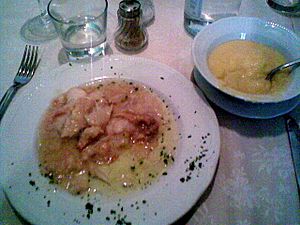
Some popular dishes are:
- Baccalà alla vicentina: A dish made with dried codfish.
- Risi e bisi: A tasty dish of rice and green peas.
- Polenta e Osei: Polenta with small birds (though often made with other meats now).
- Bigoli all'arna: Thick fresh egg noodles with duck sauce.
- Putana: A fruit cake traditionally made with simple ingredients like old bread and dried fruit.
People from other parts of Italy sometimes jokingly call the people of Vicenza mangiagatti, which means "cat eaters." This comes from a story that people in Vicenza ate cats during very hard times, like during World War II.
Famous People from Vicenza
- Amy Adams, American actress
- Roberto Baggio, football player
- Miki Biasion, rally driver
- Marzia Bisognin, YouTube celebrity
- Gelindo Bordin, athlete
- Gentullio "Tullio" Campagnolo, bicycle part inventor
- Carlo Cracco, chef and TV personality
- Federico Faggin, inventor
- Antonio Fogazzaro, writer
- Luigi Meneghello, writer
- Andrea Palladio, architect
- Antonio Pigafetta, explorer
- Paolo Rossi, football player
- Vincenzo Scamozzi, architect
- Sharon Tate, American actress and model
Sister Cities
Vicenza is connected with these cities around the world:
 Annecy, France (since 1995)
Annecy, France (since 1995) Pforzheim, Germany (since 1991)
Pforzheim, Germany (since 1991) Wuxi, China (since 2006)
Wuxi, China (since 2006) Cleveland, Ohio, U.S. (since 2009)
Cleveland, Ohio, U.S. (since 2009)
See also
 In Spanish: Vicenza para niños
In Spanish: Vicenza para niños


